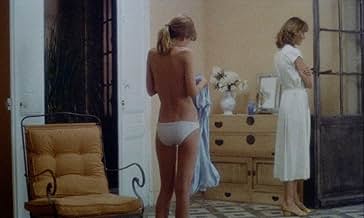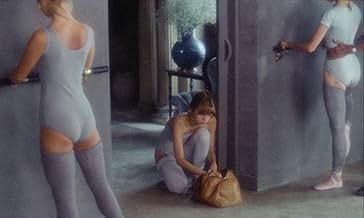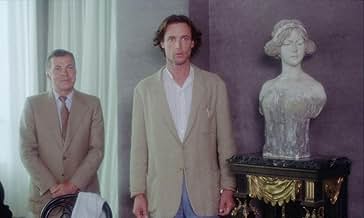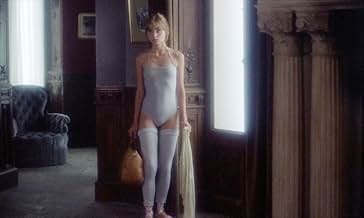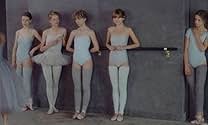IMDb रेटिंग
5.6/10
1.5 हज़ार
आपकी रेटिंग
अपनी भाषा में प्लॉट जोड़ेंSculptor Paul is reunited with a former great love after a long time, but is much more impressed by his 15-year-old daughter, Laura, who looks like her mother when Paul was in love with her.Sculptor Paul is reunited with a former great love after a long time, but is much more impressed by his 15-year-old daughter, Laura, who looks like her mother when Paul was in love with her.Sculptor Paul is reunited with a former great love after a long time, but is much more impressed by his 15-year-old daughter, Laura, who looks like her mother when Paul was in love with her.
- निर्देशक
- लेखक
- स्टार
William Milié
- Le chorégraphe
- (as William Millie)
Gunilla Astrom
- Diane
- (बिना क्रेडिट के)
Bernard Daillencourt
- Docteur Benoît
- (बिना क्रेडिट के)
David Hamilton
- Un invité à la réception
- (बिना क्रेडिट के)
Katia Kofet
- Claudie
- (बिना क्रेडिट के)
Luciano
- Timothez Sega
- (बिना क्रेडिट के)
Michael Pochna
- Gérard
- (बिना क्रेडिट के)
Anja Schüte
- Dancer
- (बिना क्रेडिट के)
फ़ीचर्ड समीक्षाएं
David Hamilton is so impressed with himself as a photographer, that he has convinced himself he can make a good film. Well, he's wrong. For example, I have a theory that he saw a good use of a fade out in a movie once and thought that if one fade out is good, then 75 of them must be great! Again, he's wrong. There is one sequence where Sarah (Maud Adams) is speaking to her daughter Laura (Dawn Dunlap) who is lying in bed. The camera shows Sarah talking and then slowly fades out to black only to shift to Laura in bed as she responded directly to her mother and continues the conversation. Maybe Hamilton felt this would make the dialogue have more resonance. Again, he's wrong. I've noticed that Hamilton is wrong a lot in this film. The movie fails on so many levels that I cannot begin to list them all here. All I can say is that you should avoid this movie at all costs. I give it a 1/10.
I agree more or less with all the comments sent so far. This might be surprising, because they seem to be so different. But they are sent from different points of view, and if you try to make a resume, you'll see how it all fits well. Let's make an example: "Glengarry Glen Ross" (or some similar indoor drama) can be described as perfect deep (by drama lovers) or terribly unwatchable slow boring movie (by action lovers); great example how a masterpiece can be made without a single female role (artistic purist statement), or a glorifying men in business and so neglecting women (a feminist statement) or even a pointless flick with no chicks to look at (a macho statement); a movie where authors bravely use words that people use in reality, or a blasphemy with an obscene language that would fit only in NC-17 movie.
I admire and adore Hamilton's work as a photograph. But, yes, being a genius in one art doesn't automatically mean you can make masterpieces in other arts (Barbara Streissand is an exemption). Some great movie photographers made movies (like Nykvist), but they learned job with people like Tarkovsky. Hamilton made only still pictures, and this is what he does best. I think making movies was not a bad idea, but he should have made them as a photographer and leave directing to a professional. Then he could have avoided some real mistakes described in earlier comments. But I wouldn't be too strict. If you don't expect too much his movies won't disappoint you. Of course, if you don't accept nudity, this is not a movie for you, but such audience knows they should avoid Hamilton's work in general. People who believe showing nude young bodies is a sin are entitled to their opinions; but if you believe such a movie could induce child molestation, you should also ban all crime movies, thrillers (not to mention horrors), movies where people smoke, eat fast food, hurt each other in any way, appear in dangerous situations (most adventure movies from Tom Sawyer and Tarzan to Indiana Jones) etc. - such behaving can also be imitated, even more dangerously (there is no violence in Hamilton's movies!). And a man who can't tell reality from a movie is a psychopath who will cross the line of crime sooner or later regardless the movies he watches.
Back to Laura and Hamilton. In Laura he made probably his most beautiful scenes, like Laura going out from the sea, and the opening sequences are his typical. And the scene some don't like, some find controversial, when Laura dances and her mother takes pictures, is a real homage to photography as art. It is an artist-model and not a mother-daughter relation. With a photo (or pencil, or canvas) in his hand an artist leaves his real world, stops being a member of family, race, nation, he creates a new world. Here Hamilton gives us a short lesson of making photos, feeling the light (Hamilton's strongest tool), lines, movements. If a picture paints a thousand words this scene saves a million words if you want to make a documentary about Hamilton himself. And this is where I agree with some of earlier comments, his work talks enough, he should stay behind camera. No words. Less directing.
A film, though with weak script and much too big oscillations in directing, was saved by great acting and again (like in Bilitis) by perfect music. For Hamilton fans - don't expect "La Dance" or "Dreams of a Young Girl", but you'll like it. The others, if not too easily offended, probably won't turn the TV off, but it's also very likely they won't remember it too long.
I admire and adore Hamilton's work as a photograph. But, yes, being a genius in one art doesn't automatically mean you can make masterpieces in other arts (Barbara Streissand is an exemption). Some great movie photographers made movies (like Nykvist), but they learned job with people like Tarkovsky. Hamilton made only still pictures, and this is what he does best. I think making movies was not a bad idea, but he should have made them as a photographer and leave directing to a professional. Then he could have avoided some real mistakes described in earlier comments. But I wouldn't be too strict. If you don't expect too much his movies won't disappoint you. Of course, if you don't accept nudity, this is not a movie for you, but such audience knows they should avoid Hamilton's work in general. People who believe showing nude young bodies is a sin are entitled to their opinions; but if you believe such a movie could induce child molestation, you should also ban all crime movies, thrillers (not to mention horrors), movies where people smoke, eat fast food, hurt each other in any way, appear in dangerous situations (most adventure movies from Tom Sawyer and Tarzan to Indiana Jones) etc. - such behaving can also be imitated, even more dangerously (there is no violence in Hamilton's movies!). And a man who can't tell reality from a movie is a psychopath who will cross the line of crime sooner or later regardless the movies he watches.
Back to Laura and Hamilton. In Laura he made probably his most beautiful scenes, like Laura going out from the sea, and the opening sequences are his typical. And the scene some don't like, some find controversial, when Laura dances and her mother takes pictures, is a real homage to photography as art. It is an artist-model and not a mother-daughter relation. With a photo (or pencil, or canvas) in his hand an artist leaves his real world, stops being a member of family, race, nation, he creates a new world. Here Hamilton gives us a short lesson of making photos, feeling the light (Hamilton's strongest tool), lines, movements. If a picture paints a thousand words this scene saves a million words if you want to make a documentary about Hamilton himself. And this is where I agree with some of earlier comments, his work talks enough, he should stay behind camera. No words. Less directing.
A film, though with weak script and much too big oscillations in directing, was saved by great acting and again (like in Bilitis) by perfect music. For Hamilton fans - don't expect "La Dance" or "Dreams of a Young Girl", but you'll like it. The others, if not too easily offended, probably won't turn the TV off, but it's also very likely they won't remember it too long.
David Hamilton's "Laura" has got to be one of the most gorgeous erotic films of all time. The story of a young girl's sexual awakening is a rather simple one, and certainly more based on fantasy (more specifically, 'male fantasy') than reality. 15 year-old Laura (Dawn Dunlap) lives in a pastel world where everything is white, everyone is beautiful, and nothing is quite real. Laura develops a fascination with the much older Paul, a sculptor with an eye for a special kind of beauty. The conflict here, is that Paul is the former lover of Laura's mother Sara, (Maud Adams). Here develops a classic situation of mother/daughter competition. When Paul sees the beautiful Laura, he is smitten, at the girls beauty, and also at how she resembles Sara, at age 15. Sara's attempts to keep the two separate are not entirely successful. Filmed on the French Riviera, in soft focus style, by renowned photographer Hamilton, you can imagine the look of the film, if you are familiar with his work. It is strange, quiet, dreamlike, quite unlike anything i have seen before. Quite controversial too. Dawn Dunlap, who was not so much older than the character she played, is very graceful and nice to look at, and former Bond girl Maud Adams is incredibly beautiful in this one as well. Although the character of Paul, (James Mitchell) is supposed to be close to 50 years old, the relationship between him and Laura is not so hard to take, as he is also a very handsome guy, who looks nowhere near his age. Also worthy of mention is the lush, dreamlike soundtrack that accompanies these images. One scene that stands out is a dream sequence; Filmed in black & white, Laura is running through a maze of little streets and alleys, looking for Paul, but he continues to allude her. Very nicely done. Hamilton creates a kind of quiet suspense, as the viewer waits for the time when the two get together. While there is nudity in the film, it is all done with the utmost of taste and subtlety. One thing: I cannot stress how important it is when watching this film, that you see the original French language version. The English dubbing for this one is wretched, absolutely dire. It is not even proper English, but American English, and it totally destroys the feeling and tone of this very French film. I first saw it in English, and I didn't think too much of the film, as the visuals were great, but the voices and dialog were so bad. When i saw the French version, it was like another experience entirely. Usually i don't mind voice dubbing so much, but here it is intolerable. I think that a lot of reviewers here have only seen the easier to find English version, which might explain the films low rating. "Laura" is a very classy erotic film, in it's original French language.
I was 12 when this came out, saw it later in the 80s and currently picked up the dvd at a charity shop and watched it again as an old man lol. It was nice to see something you saw as a young man and look back and realize how simple yet complex being young was in those days, we were kids but thought we were adults at 15, (Dawn was 17 in real life) most of us were experimenting or well past at that age, or at least my crowd was. I remember a few girls in grade 8 that looked 18 that were carrying on with our gym teacher on lunch breaks in his van doing the cheech and chong and get naked routine, (yes Julie L I'm referring to you ha ha)
As far as the movie goes it was all over the place and though it didn't seem to be put together well, it made sense. Some people have commented why the mother sent pics but wouldn't allow him to see Laura, well she wanted him to remember her and tempt him back using Laura's beauty since her marriage was dead. She wanted him for herself until she realized he only loves illusions of women. That's why she wasn't angry at her daughter or Paul when she allowed the daughter to say goodbye to her "ballet friends" but saw him instead before being sent away to school or wherever, mom knew it would be good for her to close that chapter and Paul was innocent enough. Another comment was how did Paul just walk in the ballet class and not get questioned? Well his helper was in the class and invited him along to see the girls, simple. As far as the age gap, looking at it with North American eyes it may seem a little too much, but in France you can drink wine at 12, date older men and it's nothing to look twice at, I think it was a nice slice of coming of age and reminding us we were all nubile and young at one point, we never change totally, just grow older.
As far as the movie goes it was all over the place and though it didn't seem to be put together well, it made sense. Some people have commented why the mother sent pics but wouldn't allow him to see Laura, well she wanted him to remember her and tempt him back using Laura's beauty since her marriage was dead. She wanted him for herself until she realized he only loves illusions of women. That's why she wasn't angry at her daughter or Paul when she allowed the daughter to say goodbye to her "ballet friends" but saw him instead before being sent away to school or wherever, mom knew it would be good for her to close that chapter and Paul was innocent enough. Another comment was how did Paul just walk in the ballet class and not get questioned? Well his helper was in the class and invited him along to see the girls, simple. As far as the age gap, looking at it with North American eyes it may seem a little too much, but in France you can drink wine at 12, date older men and it's nothing to look twice at, I think it was a nice slice of coming of age and reminding us we were all nubile and young at one point, we never change totally, just grow older.
Sometimes a movie can be merely about its images, like this one. The story can be about the images too.
I was very impressed with the way vignettes were composed. Rather lovely, most of them except for the annoying fade to black at the end of each and every one. To appreciate this, or rather to not be offended, I suppose you have to accept that the female form is appealing, and accept that a young girl can initiate an affair with an older man.
Besides the appeal of the balletgirls and the way they are displayed, there's the story.
It isn't much of one, surely insufficient for most commentors, and the fact that it is so slight seems to rile them a bit, as indication that the nudity was all that mattered.
But the elements of the story that do exist are what I call "folding." Usually the purpose of folding is to place the viewer in the movie, and that's the case here.
We have an artist in the writer/director who represents young girls in the nude. He and we have a surrogate on-screen, in a character who is an artist (a sculptor) and represents young girls in the nude. The titular Laura is a dancer, inviting viewers.
So far, the fold is ordinary. By the thinnest of plot devices, our sculptor goes blind after starting a sculpture of Laura. So she offers to be the model, allowing him to caress her on every part, sufficiently to make a clay copy, which he similarly caresses. She, meanwhile has a crush on him and seduces him during this process.
See the fold? We not only get to look but touch, and that touch is returned.
No, ma'am that's not a slight story. No, not at all.
Ted's Evaluation -- 2 of 3: Has some interesting elements.
I was very impressed with the way vignettes were composed. Rather lovely, most of them except for the annoying fade to black at the end of each and every one. To appreciate this, or rather to not be offended, I suppose you have to accept that the female form is appealing, and accept that a young girl can initiate an affair with an older man.
Besides the appeal of the balletgirls and the way they are displayed, there's the story.
It isn't much of one, surely insufficient for most commentors, and the fact that it is so slight seems to rile them a bit, as indication that the nudity was all that mattered.
But the elements of the story that do exist are what I call "folding." Usually the purpose of folding is to place the viewer in the movie, and that's the case here.
We have an artist in the writer/director who represents young girls in the nude. He and we have a surrogate on-screen, in a character who is an artist (a sculptor) and represents young girls in the nude. The titular Laura is a dancer, inviting viewers.
So far, the fold is ordinary. By the thinnest of plot devices, our sculptor goes blind after starting a sculpture of Laura. So she offers to be the model, allowing him to caress her on every part, sufficiently to make a clay copy, which he similarly caresses. She, meanwhile has a crush on him and seduces him during this process.
See the fold? We not only get to look but touch, and that touch is returned.
No, ma'am that's not a slight story. No, not at all.
Ted's Evaluation -- 2 of 3: Has some interesting elements.
क्या आपको पता है
- ट्रिवियाWhen Laura is in the ballet shower, many of the poses duplicate paintings of Edgar Degas (an artist famed for his ballerina portraits).
- इसके अलावा अन्य वर्जनThe German cut is ten minutes shorter than the regular version at 85 mins.
टॉप पसंद
रेटिंग देने के लिए साइन-इन करें और वैयक्तिकृत सुझावों के लिए वॉचलिस्ट करें
- How long is Laura?Alexa द्वारा संचालित
विवरण
- रिलीज़ की तारीख़
- कंट्री ऑफ़ ओरिजिन
- भाषा
- इस रूप में भी जाना जाता है
- Laura, Les Ombres De L'été
- फ़िल्माने की जगहें
- उत्पादन कंपनियां
- IMDbPro पर और कंपनी क्रेडिट देखें
इस पेज में योगदान दें
किसी बदलाव का सुझाव दें या अनुपलब्ध कॉन्टेंट जोड़ें


